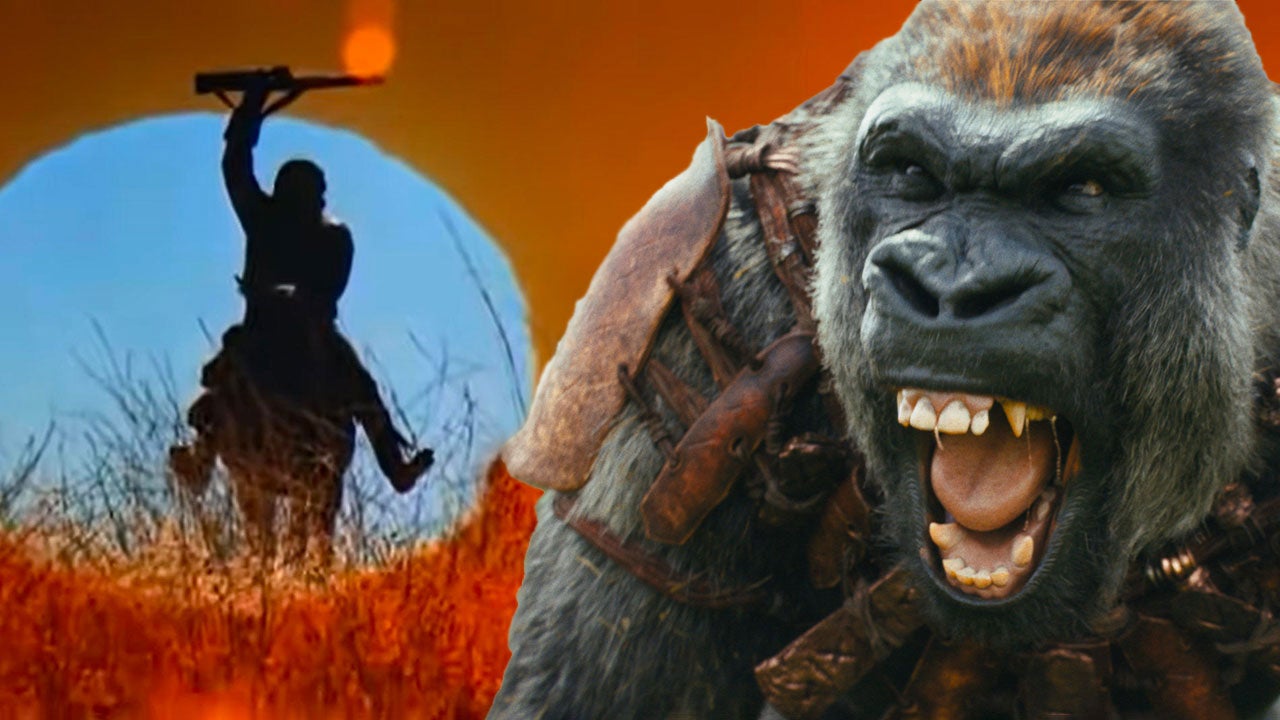Every time we get a trailer for a new Planet of the Apes movie, people wonder just where the latest film in the venerable series takes place in the Apes timeline. From the Andy Serkis trilogy to the original movies to various other offshoots, this is a franchise that spans thousands of years. And not just that, but it also takes place over a variety of timelines.
Basically, the chronology of the Planet of the Apes movies is a total mess, totally crazy, but also – and this is the most important part – totally awesome. But where to start when explaining the Planet of the Apes timeline? It’s a complicated question when you’re dealing with a cyclical, if ever-evolving, chronology where there’s no beginning or end. This is time travel, people! But we’ll get to that shortly, because the most sensible place to begin would seem to be with the most recent so-called “reboot” series that kicked off in 2011, and which is directly connected to the newest film, Kingdom of the Planet of the Apes.
Rise of the Planet of the Apes (circa 2008 to 2016)
The first of these films was Rise of the Planet of the Apes, starring James Franco as Will Rodman, a, ummm, chemist who’s working on a cure for Alzheimer’s disease. He secretly adopts a baby chimpanzee that was born in his lab, naming it Caesar, and of course the chimp grows up to be Andy Serkis in a performance-capture suit… but also a freedom fighter for apes everywhere.
Through Rodman’s experimental drugs ALZ-112 and ALZ-113, Caesar gains human-like intelligence and the ability to speak. Caesar later shares the drug with other apes. Unfortunately, or fortunately actually because there wouldn’t be a Planet of the Apes otherwise, the second drug also causes what will become known as the Simian Flu, eventually leading to a devastating worldwide pandemic for humanity. And yeah, it’s all basically James Franco’s character’s fault, even if he didn’t mean it.
Sidenote: I was lucky enough to visit the set of this movie way back when they were filming in Vancouver, and Franco would spend his time between takes just sitting in the shade of a tree and reading. Which kinda seemed like a really douchey way to act in front of the visiting press? Though actually, what’s more douchey? Reading, or making fun of someone for reading? It’s that kind of attitude that will lead to a Planet of the Apes!
Anyway, the events of this film take place more or less in the present day of when Rise was released, so figure from Caesar’s birth in 2008 through 2016 or so, when Caesar and his fellow apes stage their first battle for freedom against humanity on the Golden Gate Bridge. Rise ends with Caesar and his apes embarking on a new life in the forests of Northern California even while the apocalypse approaches for an unknowing mankind. Great job, Franco!
And by the way, there are a bunch of Easter Eggs in Rise which might confuse more casual viewers who think they’re meant to be bigger connections to the original Planet of the Apes series. Character names like Dodge, Landon, Maurice, Bright Eyes, and others are callbacks to the 1968 film, but nothing more. A more interesting bit, however, involves the mention of a space vessel called the Icarus which launches and subsequently is lost in space. We’ll get to the importance of that shortly… well, in a few thousand years.
Dawn of the Planet of the Apes (circa 2026)
By the next film, which takes place 10 years later, the Simian Flu has ravaged mankind and society has collapsed. Billions have died offscreen. And James Franco’s character too!
Meanwhile, Caesar and his apes have flourished and multiplied, building their own society which co-exists precariously with the remnants of humanity in their region. The apes encounter some friendly humans in Jason Clarke and Keri Russell’s characters, whose names aren’t really worth remembering because like all the humans in this reboot trilogy, they’re one and done after a single movie. Caesar also runs into trouble with one of his lieutenants, Toby Kebbell’s great character Koba, a tortured survivor of animal experimentation who is most certainly not down with HUMAN WORK.
Anyway, Koba tries to assassinate Caesar and attacks the humans, and over on the human side Gary Oldman is being kind of a dick too. Ultimately, even though Caesar is able to defeat his former friend, the damage is done: War between the humans and the apes is inevitable.
And I’ll just pause for a second again here to say that I also got to visit this set during production, and the set of the next movie too, War for the Planet of the Apes. For someone who grew up watching Apes Week every year on New York’s local ABC affiliate, doing these and other Apes opps was some kind of dream come true. Also, Andy Serkis is cool as shit.
War for the Planet of the Apes (circa 2028)
Two years later, a human military group known as Alpha-Omega is hunting for Caesar and his fellow apes. Their leader, Woody Harrelson's Colonel – who you can say hates every ape he sees from chimpan-A to chimpan-Z – murders Caesar’s wife and eldest son. Meanwhile, things go from bad to worse for humanity, as the Simian Flu has now mutated into a form which affects even those who were previously immune to it. It’s now causing its subjects to lose the ability to speak and in some cases to revert to a more primitive mental state. Yep, it’s definitely happening: Earth is turning into a Planet of the Apes!
Caesar’s group takes in a mute human girl, indicating that apes and humans could still live together peacefully if they have the will. And while the girl goes by the name Nova, which is a reference to Linda Harrison’s Nova from the original 1968 movie, this is not the same character. I mean, they’re separated by thousands of years for one thing, and seemingly live in different timelines too.
We also meet Steve Zahn’s Bad Ape, who stands as proof that the heightened intelligence of Caesar’s apes has spread to others beyond their tribe. By the end of the film, the Colonel is defeated, succumbing to the mutated Flu, and Caesar dies after ensuring that his apes are able to escape to a lush new land across the desert where they can begin to build a new life for their people. Uh, apes. Apes-people?
Kingdom of the Planet of the Apes (several generations after Caesar)
Kingdom of the Planet of the Apes (review) leaves Caesar’s story behind to jump ahead to what 20th Century Studios describes as “several generations in the future following Caesar’s reign, in which apes are the dominant species living harmoniously, and humans have been reduced to living in the shadows.”
Anyway, let’s let Bad Ape sum things up for us so far. As he explains in War for: “Human get sick. Ape get smart. Then human kill ape. But not me. I run!”
So as humans progressed to a more primitive state, ape civilization continued to grow. But how does that connect to the classic movies? One thing’s for sure. We need to travel to a different timeline from here!
Planet of the Apes (circa 3955/3978)
O.K., now we’ve finally arrived at the beginning, which is also the end, but for the purposes of this piece is just sort of the middle point of the story. The original classic from 1968 plopped Charlton Heston’s Colonel George Taylor into the mixed-up world of the Planet of the Apes after he and his crew spent a couple of millennia in hyper-sleep onboard their ship the Icarus, also known as the Liberty 1.
At this point in the future, apes rule the land, and humans are mute savages. After getting put through the ringer in this madhouse of a world by Dr. Zaius, Taylor – perfect human specimen that he is – manages to escape. And it’s only then that he finds what a lot of you first discovered while watching The Simpsons and/or Spaceballs: the destroyed Statue of Liberty, meaning humanity had blown itself to hell centuries ago.
Also, you may recall that the Icarus was the ship that was mentioned back in Rise of the Planet of the Apes. The only thing is, Taylor’s Icarus launched in 1972, which is decades before the Icarus in Rise’s mission. So while a Taylor may wake up and find a Planet of the Apes 2000 years after Rise, it won’t be the Taylor from the first movie. Different timeline.
And no, I didn’t visit the set of this movie. I’m not that old.
Beneath the Planet of the Apes (circa 3955/3978)
Ah, one of the nuttiest entries in the OG series, and that’s saying a lot, Beneath the Planet of the Apes picks up where the last movie left off, more or less, only without Heston for much of its running time. He didn’t want to come back for a sequel, and only agreed to an abbreviated role if he could be assured that Taylor would be killed. And man, did he get his wish.
In his place is the Taylor Light Brent, played by James Franciscus, who goes through most of the motions of the first movie (spaceship, Ape City, and so on) before unearthing a new level – literally – of the Planet of the Apes. Brent discovers a group of human mutants who have been, shall we say, altered by the effects of the nuclear war that happened all those centuries ago and led to stuff like the Statue of Liberty becoming beachfront property. Indeed, these face-peeling mutants actually worship a doomsday weapon called the Alpha-Omega bomb, just like the name of Woody Harrelson’s group of militants. And while Harrelson’s Colonel wasn’t literally pulling his face off, his soldiers were mutating in new ways last time we saw them. Who’s to say that in that timeline, some of them didn’t splinter off and form an underground group of psychic crazies like this lot?
Real quick, a note about dates: Taylor’s control panel in the 1968 movie says he’s landed in the year 3978. Brent in Beneath says it’s 3955, even though he clearly gets there after Taylor. It’s just a production mistake, guys. Don’t overthink it.
Anyway, this one culminates in one of the most insane endings in movie history as Nova buys it, Brent gets machine-gunned, and Taylor takes several rounds to the chest himself, but lives long enough to set off the Alpha-Omega device, destroying the entire planet along the way.
But you know what they say: The timeline must go on!
Escape From the Planet of the Apes (circa 1973)
How do you make a sequel to your hit franchise when you’ve killed everyone and blown up the planet? Time travel, of course.
And so it went that, after taking a spin on the Icarus, the two lovable chimpanzees who befriended Taylor in the first movie wound up in 1973. Putting Roddy McDowall’s Cornelius and Kim Hunter’s Zira in what was the modern day at the time of Escape From the Planet of the Apes’ release was a pretty brilliant flip on the original film’s conceit, and it breathed new life into the franchise as the two chimps have a madcap adventure in modern man’s world. That is, until they too get gunned down in a finale that remains as jarring and troubling today as it must’ve been 50 years ago.
This is also where we first meet the original series’ version of Caesar, though he’s called Milo here and is just the baby of Cornelius and Zira. Through a switcheroo involving Ricardo Montalban of all people, Milo’s parents die so that he can live. We’ll see him again in the next movie, where he chooses the name Caesar for himself.
Conquest of the Planet of the Apes (circa 1991)
18 years after the murder of his parents, Caesar – Roddy McDowall playing his own son – is living in a much-changed world. After the decimation of all the dogs and cats on Earth due to a mysterious plague, apes became mankind’s new pets. But soon that evolved into them becoming slaves, even as American society morphed into something of a totalitarian state. The perfect forum for Caesar to begin his rebellion.
The timeline is pretty straightforward at this point as Caesar fulfills his destiny of leading his fellow apes against humankind. And the seeds are planted for the apes to become much more human-like, as they’re wearing clothes now but also, and inexplicably, Caesar’s future wife Lisa speaks for the first time. In fact, she says “no” just as Aldo was meant to in that other timeline, only she does so in an effort to stop the violence rather than start it. That tension between peace and war is always a key part of Caesar’s story, it seems.
Battle for the Planet of the Apes (early 21st century/circa 2670)
Seemingly taking place a couple of decades after Conquest, this final film in the original series gives us a much kinder, gentler Caesar. He’s now a family man and the benevolent leader of a colony of both apes and humans. But the humans are second-class citizens, and there are clearly tensions with apes like the militaristic gorilla Aldo – who, by the way, seems to be related to the Aldo of legend in name only.
The nuclear war that has been alluded to throughout the series has also taken place since the last movie, and the humans who will eventually evolve into the face-peeling mutants in Beneath the Planet of the Apes are out to get Caesar and his tribe here. By the end of the film they retreat to their subterranean dwellings, but in deleted footage the Alpha-Omega bomb is seen. These guys are gonna worship this thing one day!
This story is bookended by a sequence set over 600 years later and featuring the Lawgiver, as played by none other than famed director John Huston in ape makeup. The Lawgiver is a legendary figure who formed the basis of ape society and laws according to the earlier films, and his sequences here are meant to establish a fork in the road for apes and humans. Will the changes that were seemingly made to this timeline by Caesar mean that all can live together in harmony in the future, thereby avoiding Chuck Heston blowing the shit out of everything eventually? The weird closing image of a statue of Caesar shedding a tear seems to have an appropriately downbeat answer for this series: no freaking way.
Planet of the Apes TV Shows (circa 3085/circa 3979)
There were two short-lived TV series released in the 1970s after the original movies had run their course. The first, simply called Planet of the Apes, was live-action and starred Roddy McDowall as a friendly chimpanzee named Galen. Ron Harper and James Naughton also starred as a pair of astronauts from the 20th century who hit a time warp and landed in the year 3085, where it’s not so great to be a human.
The series’ place in the original timeline is a bit unclear. Technically, these astronauts should be experiencing their adventure-of-the-week style stories some 900 years before Taylor crashes back to Earth in the original movie, and about 400 years after the Lawgiver’s whole spiel in Battle.
But there are inconsistencies too, like the existence of dogs, which were said back in Escape to have been wiped out by a plague. There’s also a Doctor Zaius character, who could just be a different orangutan with the same name who’s also a jerk, but is clearly designed to be a version of the Zaius from the movies. We also learn that humanity was still running things by the year 2503, which definitely doesn’t line up with the fourth and fifth films in the original series.
Still, maybe this means that this show exists in the original timeline from before Taylor arrived in the future. The one where Aldo said “no,” right? If so, that means Taylor and then Brent’s time-travelling led to Cornelius and Zira’s time-travelling, which created an alternate timeline where their child Caesar led the apes to revolt centuries earlier than had been the case in the original timeline before Taylor arrived. Got that?
And then there’s the animated TV series, Return to the Planet of the Apes. This show depicts a very different world than the one Taylor discovered, even though Return is set just one year after the 1968 movie. The Apes have relatively modern technology, there’s an astronaut named Brent who is definitely not the same Brent from Beneath the Planet of the Apes, and so on. Also, the animation is real rough. Best to just keep this one in an alternate timeline as well.
Tim Burton’s Planet of the Apes (circa 2029/circa 5021)
Oh yeah, and then there’s this. The remake or reboot or whatever you want to call it from 2001 seemed like a good idea at the time. Tim Burton reviving the Apes franchise after it had been dormant since the ’70s? Hell yeah! But something went wrong along the way in this tale of an astronaut played by Mark Wahlberg who winds up in a future where… well, come on. You know where this is going.
The Planet of the Apes in this movie isn’t even Earth. That is, until the end of the film when Wahlberg seems to make it back home. It’s the most memorable – and confusing – part of the whole experience as Wahlberg finds that Earth is apparently now ruled by apes for some reason, and the film’s bad guy – General Thade – is now immortalized where the Lincoln Memorial used to be.
Alternate timeline? Big time.
So what’s the most confusing part of the Apes timeline for you? Let’s discuss in the comments! And for even more, check out how to watch the Planet of the Apes movies in chronological order.
Talk to Scott Collura on Twitter at @ScottCollura, or listen to his Star Trek podcast, Transporter Room 3. Or do both!






